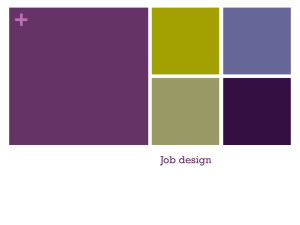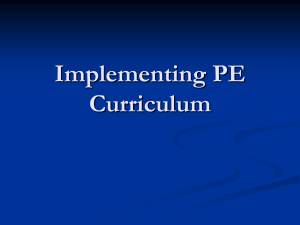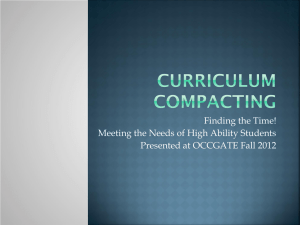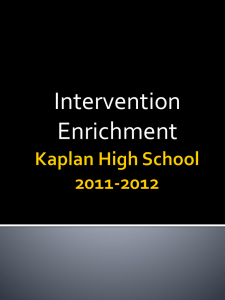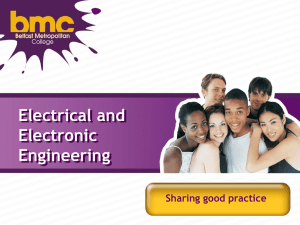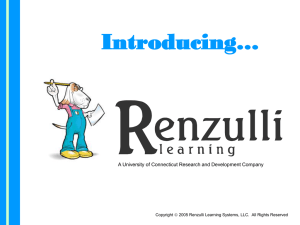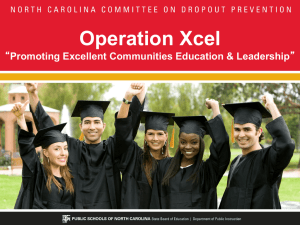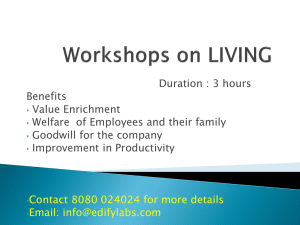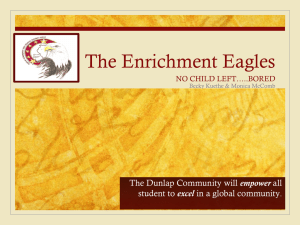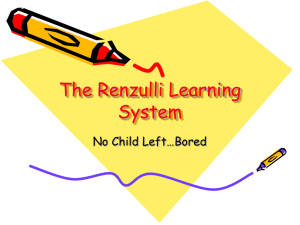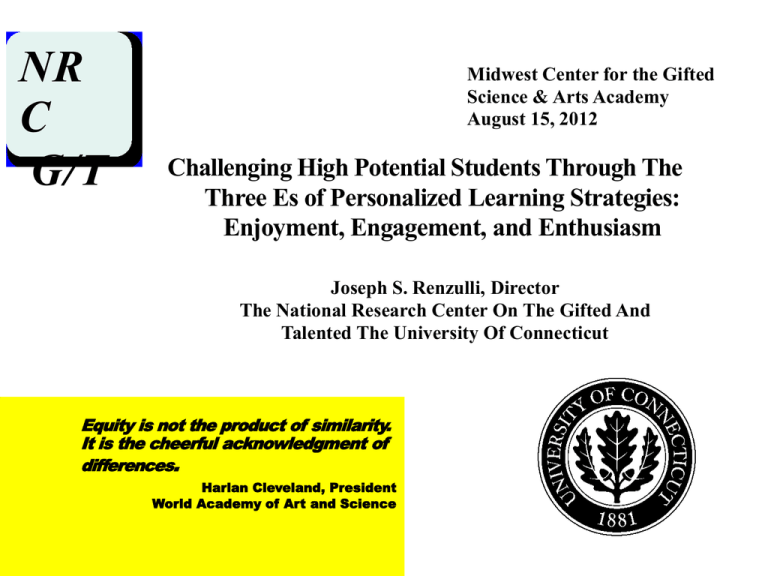
NR
C
G/T
Midwest Center for the Gifted
Science & Arts Academy
August 15, 2012
Challenging High Potential Students Through The
Three Es of Personalized Learning Strategies:
Enjoyment, Engagement, and Enthusiasm
Joseph S. Renzulli, Director
The National Research Center On The Gifted And
Talented The University Of Connecticut
•
Equity is not the product of similarity.
It is the cheerful acknowledgment of
differences.
Harlan Cleveland, President
World Academy of Art and Science
www.gifted.uconn.edu
www.gifted.uconn.edu/sem
[Articles]
www.renzullilearning.com
High-End Learning
Teacher Roles and Responsibilities
List the roles you fulfilled in addition to or in place of instructor and
disseminator of information?
q
q
q
q
q
q
q
q
q
q
q
q
q
q
General Contractor
Conductor (as in a symphony)
Consultant
Counselor
Accountant, Fund Raiser
Operations Manager
Business Agent
Forager/Scavenger
Therapist, Confidant
Advocate
Production Manager
Secretary
Internet Detective
Recorder (for young kids)
q
q
q
q
q
q
q
q
q
q
q
q
q
q
q
Librarian
Taxi Driver
Coach
Producer, Director, Stage Manager (as in a play)
Press Agent
Talent Scout
Arbitrator
Auditor
Supply Sergeant
Transportation Coordinator
Caterer
"Fixer" (something like a lawyer)
Friend
Editor
Collaborator
You gotta have a dream...
Nothing happens unless first a dream.
Carl Sandburg
Champions aren’t made in the gyms.
Champions are made from something
deep inside them...
A desire, a dream, a vision.
Muhammad Ali
You gotta have a dream,
if you don't have a dream,
How you gonna have a dream come
true?
Happy Talk from South Pacific
Goals
Enjoyment
Engagement
Enthusiasm
For Learning
Have you ever?
SPORTS
Soccer Football
Field Hockey
Gymnastics
Basketball
Baseball
Softball
Swimming
Diving
Track and
Field
WRITTEN, VISUAL, AND
PERFORMING
ARTS
Drama Productions
Newspaper
Band
Creative Writing
Workshop
Yearbook
Chorus
Computer/Graphic Design
Fashion Design
Video/Filmmaking
CLUBS/EXTRACURRICULAR ACTIVITIES
Future Problem Solving
National History Day
Cooking Club
Mock Trial
Model UN
Outward Bound
Service Clubs
4-H
Junior Achievement
Invention Convention
Boy Scouts/Girl Scouts
Photography Club
Future Farmers of America
Three Questions....
1. Who came to your group?
2. What did the students do ?
3. What role did you play?
What did you do?
What different jobs, activities, and services did you provide for
your group?
High-End Learning
Teacher Roles and Responsibilities
List the roles you fulfilled in addition to or in place of instructor and
disseminator of information?
q
q
q
q
q
q
q
q
q
q
q
q
q
q
General Contractor
Conductor (as in a symphony)
Consultant
Counselor
Accountant, Fund Raiser
Operations Manager
Business Agent
Forager/Scavenger
Therapist, Confidant
Advocate
Production Manager
Secretary
Internet Detective
Recorder (for young kids)
q
q
q
q
q
q
q
q
q
q
q
q
q
q
q
Librarian
Taxi Driver
Coach
Producer, Director, Stage Manager (as in a play)
Press Agent
Talent Scout
Arbitrator
Auditor
Supply Sergeant
Transportation Coordinator
Caterer
"Fixer" (something like a lawyer)
Friend
Editor
Collaborator
The Definition of
The-Guide-On-The-Side
Activity
Today’s Outline
1.
2.
3.
4.
5.
6.
Background and The General Theory
How Do We Identify High Potential In Young People
How Do We Develop Gifts and Talents In Young People
Curriculum differentiation and Compacting
The enrichment Triad Model
Enrichment Clusters & Academies of Inquiry and Talent
Development
7. Practical Hint # 1: Learn all you can about and obtain
copies of How-To Books
8. Practical Hint # 2: Think Data/Think Instruments
9. Practical Hint # 3: Use Infusion to tame the turkey!
10. Last Practical Hint: Get Renzulli Learning
General
Background
The Three Part Focus of Our Research and
The Practical Core of Our Work
Academic Strength Assessment (Aptitude Tests + SRBCSS)
Interest Assessment (I-A-L)
Learning Styles Assessment (LSI)
Expression Styles Assessment (My Way)
Assessment of Co-cognitive Functions (Leadership & Other
Executive Functions)
Part 2. Services To Students
Curriculum Modification For High Achieving Students
General Enrichment Opportunities For All Students
Advanced Enrichment For Targeted Students
Internet Based Enrichment Resources
Part 3. Technology Delivery System
Parts 1 and 2 can only be delivered effectively with
the use of appropriate theory based technology
The Big Five
Part 1. Assessment
The Three Part Focus of Our Research and
The Practical Core of Our Work
Academic Strength Assessment (Aptitude Tests + SRBCSS)
Interest Assessment (I-A-L)
Learning Styles Assessment (LSI)
Expression Styles Assessment (My Way)
Assessment of Co-cognitive Functions (Leadership & Other
Executive Functions)
Part 2. Services To Students
Curriculum Modification For High Achieving Students
General Enrichment Opportunities For All Students
Advanced Enrichment For Targeted Students
Internet Based Enrichment Resources
Part 3. Technology Delivery System
Parts 1 and 2 can only be delivered effectively with
the use of appropriate theory based technology
The Big Five
Part 1. Assessment
I know what you’re thinking!
Give me a break!
How the hell can we accommodate
all these things? I’ve got 26 kids –
some can’t add and some are
ready for calculus.
Let the machine do the
heavy lifting.
•
•
Figure 1. Renzulli Learning System
System Overview At-A-Glance
Search
Engine
Matches
Multiply
Categorized
Resources
From 50k
Item
Data Bases
With
Individual
Student
Profiles
Individualized Strength
Assessment
Reproducible Activities
Teacher Monitoring Tools
Lesson Plans & Learning Maps
Grouping By Interest Areas, etc.
Built-In Personal Success Plan
Total Talent Portfolio
Teacher Favorites Portfolio
Curricular Related “Push ‐Ins”
Built-‐In Assessment Tools
Parent Review Access
24/7/365 Usage
Staff Development Tutorials
All Activity Placed In
Electronic Portfolio
Application of Resources to
Class Work And Projects
Built In Accountability and
Staff Development for Teachers
The Three-Ring Conception
of Giftedness
Executive Functions
Fully
Functioning
Self-Actualized
Individual
Operation Houndstooth
Leadership in a Changing World
The Development of Social Capital
Conceptions of Giftedness
A Focus on Creative Productivity
Major Categories of Talent Development
The
Traditional
Basics
Creative Thinking
Critical Thinking
Problem Solving
Decision Making
Productive Thinking
Planning
Forecasting
Writing
Literacy
Numeracy
Brought to bear upon...
Opportunities For
Creative Productivity
Contributing To Social Capital & Making A Better World
• Optimism
• Mental and Physical Energy
• Courage
• Vision & A Sense of Destiny
• Romance With a Topic or Discipline • Sensitivity To Human Concerns
Intelligences Outside
The Normal Curve
Leadership Based on Wisdom & Responsibility
The Soft
Intelligences
“Executive Functions”
• Personal
• Emotional
• Spiritual
• Social
• Motivational
• Responsible
• Organizational
Getting your act
together”
•
Focusing & Filtering
Meta-cognitive Skills
in Technology
•The ability to identify trustworthy and useful information
•The ability to selectively manage overabundant information
•The ability to organize, classify, and evaluate information
•The ability to conduct self-‐assessments of web-‐based information
•The ability to use relevant information to advance the quality of one’s work
•The ability to communicate information effectively
Continuum of Learning Theories*
All you
ever
needed
to know
about
learning
theory
(in one
slide)!
Deductive
Didactic & Prescriptive
~Knowledge Acquisition,
Storage, and Retrieval.
Predetermined Content
Pedagogy
Basic Skill Acquisition
Text Consumption
Behaviorists
Pavlov
Thorndike
Skinner
Outcomes
Inductive, Investigative &
Inquiry Oriented
Knowledge Application, High
Engagement, Motivation
And Enjoyment. J-I-T Content
21st Century Thinking Skills
Creative Productivity
Major Theorists
Constructivists
Pestalozzi, Torrance,
Montessori, Gardner,
Piaget & Bruner,
Dewey, Sternberg, Renzulli
National Goals
Inventors
Creative Designers in Sciences,
Arts, & Technology
Innovative Leaders
Entrepreneurs Writers
People Who Make a Difference
Increased Academic
Achievement
Higher Test Scores
Technically Proficient
Professional and Skilled Workers
*Both ends of this continuum are important, and schools should integrate them whenever
possible to produce the best balance between the two models of learning.
Natural Sciences & Mathematics
Philosophy The Humanities
The Arts
Social Sciences Languages
Literature & Rhetoric
Technology
Law, Ethics, & Religion
(Applied Sciences)
Facts & Statistics
Beliefs, Attitudes,
& Values
Classifications, Relations
& Categories
Theories, Structures
Patterns, Trends &
Sequences
Systems, Implications &
Transformations
Principles, Concepts &
Generalizations
Investigative Methods
Trivia, Folklore, &
Insiders Information
“Giants,” Champions, &
Landmark Events
How Knowledge Is Organized
A Theory of Knowledge
The Schoolwide Enrichment Model
Joseph S. Renzulli & Sally M. Reis
School Structures
Comprehensive Strength Assessment Portfolio
Curriculum Modification Techniques
Enrichment Learning and Teaching
TYPE I
GENERAL
EXPLORATORY
ACTIVITIES
TYPE II
GROUP
TRAINING
ACTIVITIES
TYPE III
INDIVIDUAL & SMALL GROUP
INVESTIGATIONS OF REAL PROBLEMS
Regular
Classroom
Environment
In General
Service Delivery Components
www.gifted.uconn.edu
•Content Modifications
More Material
More Drill & Practice
Easier Material
Greater Depth & Complexity
Student or Teacher Selected
Enrichment Opportunities Related
To A Topic or Unit of Study
Classroom Organization:
Forum, Cinema,
Laboratory, Café, Conference,
Boardroom, Lecture Hall,
Circle, Hot Seat, Study
Carrels, Science/Media Labs,
Computer Lab, Interest
Centers, “Coffee House”
Online Courses
Flickr, Twitter
Blogs, Wikis, Podcasts
Social Networking Sites
RSS Feeders, Screencasts Renzulli Learning System
Technology
KNOWLEDGE
PEDAGOGY
Curriculum
Content
Instructional
Strategies
Classroom
Organization
Student
Products
MANAGEMENT
Grouping by:
Interests, Skill Levels, Ability,
Within & Across-‐Grade
Cluster Grouping, Common
Tasks/Projects,
Complimentary Talents,
Cooperative Learning
Learning/Teaching Styles:
Lecture, Discussion, Peer
Tutoring, Simulations
Socratic Inquiry, CAI,
Dramatization, Problem
Based Learning, Guided &
Unguided Independent Study
EXPRESSION STYL
Expression Styles:
Oral, Visual, Graphic,
Manipulative, Artistic,
Written, MultiMedia,
Service, Combinations
of the Above
Technology
Five Dimensions of Differentiation
(JSR: 1996)
Relating The Enrichment Triad Model To
Various Organizational Structures
The Pedagogy of Enrichment
Learning and Teaching (EL&T)
All
Students
{
{
Candidates
For
Follow-Up
The Enrichment Triad Model
A Pedagogical Model
(What We Do With Students)
Regular Classroom Infusion
Extension of An Individual Lesson
A Unit You Are Planning
Special Classes, Resource Room/ PullOut, Enrichment Clusters, AITDs,
Independent Study, Cluster Grouping
Extra and Co-Curricular Activities
And Other Special Events
In Your School
Various Organizational Models
(How We Group Students and
Move Them Around)
Goals
Enjoyment
Engagement
Enthusiasm
For Learning
Enrichment Team of Administrators,
Teachers, and Parents
The Schoolwide Enrichment
Team
Plans and organizes speakers
and Type 1’s
Reviews enrichment materials
and plans implementation
Organizes Enrichment Clusters
Recruits enrichment mentors
Identifies enrichment events
How Do
We Identify High
Potentials In
Young People?
WHAT MAKES GIFTEDNESS?
Task
Commitment
Above Average
Ability
Creativity
A
I
U C C
T
P
Graphic Representation of the Three-Ring Definition of Giftedness
General Performance Area
Mathematics
Philosophy
Religion
Life Sciences
Visual Arts
Social Sciences
Language Arts
Physical Sciences
.
Law
Music
Movement Arts
•
•Specific Performance Areas
•F
•-
•*This arrow should read as *… brought to bear upon …”
Cartooning
Demography
Electronic Music
Astronomy
Microphotography
Child Care
Public Opinion Polling
City Planning
Consumer Protection
Jewelry Design
Pollution Control
Cooking
Map Making
Poetry
Ornithology
Choreography
Fashion Design
Furniture Design
Biography
Weaving
Navigation Genealogy
Film Making
Play Writing
Sculpture
Statistics
Advertising
Wildlife Management
Local history
Costume Design
Set Design
Electronics
Meteorology
Agricultural
Musical Composition
Puppetry
Research
Landscape
Marketing
Animal Learning
Ar c h i t e c t u r e
Game Design
Film Criticism
Chemistry
Journalism
etc.
etc.
etc.
Two Types of Giftedness
We realize you do better on your IQ tests than you do
in anything else, but you just cannot major in IQ.
Teacher
Ratings
Action
Information
•
• In the space below provide a brief description of the
topic that
•.,---)-7
•5/ / -s,
•,s- „...-7 v, "7,.., . F, y) // " , - • ,---A-• 7 CI 0; r 73 I--0 / 7 7F2 c
-
•Oro) i
-7
4---2
To:
___ Talent Pool Class Teacher
___ Program Coordinator
___ Other
FROM: _____________________ Student (print name)
_____________________ Teacher (print name)
_____________________ Other
General Curriculum Area: _________________________________
______________________________________________________
Idea for Investigation or Study:_____________________________________________________________________
_____________________________________________________________________________________________
_____________________________________________________________________________________________
In the space below, provide a brief description of evidence of high levels of task commitment or creativity on the
part of a student or small group of students. Indicate any ideas you may have for advanced level follow-up
activities, suggested resources or ways to focus the interest into a first-hand investigative experience.
Date Received_______________
Date of Interview______________
Mentor Located ____ Yes ____ No
Name of person who will be responsible for facilitating this Tye III
_______________________________________________________________________________
Copyright © 1981 Creative Learning Press, Inc. • P O. Box 320 • Mansfield Center, CT 06250
ALL RIGHTS RESERVED
•
*These forms are prepared on 3 -part NCR paper and can be purchased in sets of 100 from the
publisher. Actual size 8'/z" x 11".
•Parent Ratings
"THINGS MY CHILD LIKES TO DO"
Your Name ______________________________________________________ Your Child's Name ____________________________________________________________
Child's Age __________________________________________Child's School _____________________________________________ Today's Date _____________________
Seldom
or Never
1. My child will spend more time and energy than
his/her agemates on a topic of his/her interest.
(For example: Joan is learning to sew and spends
every free minute designing new dress patterns
and trying to sew them herself.)
2. My child is a "self-starter" who works well alone,
needing few directions and little supervision. (For
example: After watching a film about musical
instruments, Gary began to make his own guitar
from materials he found around the garage.)
3. My child sets high personal goals and expects
to see results from his/her work. (For example:
Marj insisted on building a robot from spare
machine parts even though she knew nothing
about engines or construction.)
4. My child gets so involved with a project that
(s)he gives up other pleasures in order to work on
it. (For example: Don is writing a book about his
town's history and spends each night examining
historical records and documents—even when he
knows he's missing his favorite tv show.)
5. My child continues to work on a project even
when faced with temporary defeats and slow
results. (For example: After building a model
rocket, Sally continued to try to launch it, despite
several failures and "crash landings.")
6. While working on a project (and when it is finished) my child knows which parts are good and
which parts need improvement. (For example:
After building a scale model of a lunar city, Kenny
realized that there weren't enough solar collectors
to heat all the homes he had built.)
7. My child is a "doer" who begins a project and
shows finished products of his/her work. (For
example: Mary began working on a puppet show
four months ago, and has since built a stage and
puppets, and has written a script. Tomorrow she's
presenting her play to the PTA!)
Sometimes
Quite
Often*
Almost
Always*
Example From Your Own Child's Life
Seldom
or Never
Sometimes
Quite
Often*
Almost
Always*
Example From Your Own Child's Life
8. My child suggests imaginative ways of doing
things, even if the suggestions are sometimes
impractical. (For example: "If you really want to
clean the refrigerator, why don't we move it outside and I'll hose it down—that will defrost it,
too.")
9. When my child tells about something that is very
unusual, (s)he expresses himself/herself by
elaborate gestures, pictures, or words. (For
example: "The only way I can show you how the
ballet dancer spun around is if I stand on my tiptoes
on the record player and put the speed up to 78.")
10. My child uses common materials in ways not
typically expected. (For example: "I'll bring a deck
of cards when we go camping. If it rains, we can
use them to start a fire, and if it's dry, we can play
`fish' around the campfire.")
11. My child avoids typical ways of doing things,
choosing instead to find new ways to approach a
problem or topic. (For example: "I had trouble
moving this box to the other side of the garage so I
used these four broom handles as rollers and just
pushed it along.") .
12. My child likes to "play with ideas," often
making up situations which probably will not
occur. (For example: "I wonder what would
happen if a scientist found a way to kill all
insects, and then went ahead and did it.")
13. My child often finds humor in situations or
events that are not obviously funny to most
children his/her age. (For example: "It was really
funny that after our coach showed us a movie on
playground safety, he sprained his ankle while
lining us up to go back to class.")
14. My child prefers working or playing alone
rather than doing something "just to go along
with the gang." (For example: "I always misspell
the first word in a spelling bee; then I get to sit
down and do something I like.")
•*If your child scores in either of these two columns, it would be helpful if you would write a specific example in the last column, using the
reverse side of this page if necessary.
Areas of Learning
Standardized
Test
My Score
General Interests
Performing Arts
CT Mastery Test
Math Scaled Score
Creative Writing
CT Mastery Test
Reading Scaled Score
Fine Arts AL Crafts
Journalism
Music
Science/Experimenting
CT Mastery Test
Writing Scaled Score
Mathematics
Athletics
Other Standardized
Test
______________
Photography/Film/Video
Community Service
Other Standardized
Test
______________
Subject
Areas in
School
Rank 1-3
(1 is highest)
History
Business/Money
Current
I Really
Grade
Like:
Im
Technology/Computers
Other ____________
Good
At:
Language
Arts
Writing
Special Topics That I Like (and
would like to know more about)
Math
Social
Studies
Science
Art
Music
Physical
Education
A
Learning and Interests
Subjects in School
I
Really
Like
I’m
Good 1
At
Special Topics I Like
Or
Would Like to Know More About
Reading
Writing
Mathematics
Social Studies
Science
Art
Music
PE
Computer
Rank these 1 to 8 with 1 being your first choice.
I Comments
My Best Ways of Learning
When learning new
information at school I
like to:
Have the teacher lecture.
When showing what I’ve
learned I like to:
I learn best . . .
Write.
When it’s quiet.
Use art.
When there is some
noise.
Discuss topics with a group.
Talk about my learning.
Work on topics of my choice by
myself.
Act it out or make a video.
Learn information by watching
a video or a film.
Work on group projects.
Learn by using the computer.
Talk with a person who is an
expert on the topic.
Work with another student who
already knows the information.
Rank your top 4 choices with 1 being
your best way to learn new information.
Build a display or make a
game.
Do a project on the
computer.
When there is bright
light.
When the room has soft
lighting.
Early in the day.
Take tests.
After I’ve been awake a
few hours.
Other.
In the afternoon.
Rank your top 4 choices with 1 being
your best way to show what you’ve
learned.
Comments
At night.
When I have music
playing.
If I can snack while I
work.
Check the sections that tell about
your best ways of learning.
Pages 78 thru 89
Curriculum Compacting
Modifying the regular curriculum for
advanced learners through pre-assessment
and replacement of already mastered
material with advanced enrichment or
acceleration experiences.
From Get Off My Brain, by Randy McCutcheon, illustrated by Pete Wagner
"First grade would be all right if it weren't for the 11 sequels."
Curriculum Compacting
A systematic process for modifying the regular
curriculum by examining curricular standards, preassessing students, and making modifications to
meet individual needs.
Goals of Compacting
Create a challenging learning environment
in the classroom and “buy time” for
students who have already mastered
regular curricular material.
Define objectives and guarantee
proficiency in basic curriculum.
Provide alternative learning activities
based on advanced content and individual
student interest.
Two Kinds of Curriculum
Compacting
Basic Skill
Compacting
Spelling, Mathematics, or Language
Arts Basic Skills
Easy to implement because
pretesting is less difficult
and mastery can be
efficiently documented.
Does the student already know the skills
being covered in the classroom?
Can proficiency be documented?
Can certain skills be eliminated?
Will the student be allowed (and
encouraged) to master basic skills
at his/her own pace?
If skills can be mastered at a pace
commensurate with a student's ability,
will the student be able to help determine
what he/she will do in the time earned by
displaying mastery?
Two Kinds of Curriculum
Compacting
Content Compacting
Social Studies, Science, and
Literature
Students may already know
the objectives or may be
able to read the material
and master the objectives in
a fraction of the time.
If the student already knows the
content, will he/she have an
opportunity to display competency of
the subject or topic?
If students do not already know the
content but have the ability to master
the material at their own pace, will they
he given that opportunity?
If content mastery can be
demonstrated, will the student have
the opportunity to select the work that
will be substituted?
•
Chris A. Caram &
Patsy B. Davis
The Enrichment Triad Model
TYPE I*
TYPE II
GENERAL
EXPLORATORY
ACTIVITIES
GROUP
TRAINING
ACTIVITIES
TYPE III
INDIVIDUAL & SMALL
GROUP INVESTIGATIONS OF
REAL PROBLEMS
•
TYPE I
GENERAL
EXPLORATORY
ACTIVITIES
Interest Development Centers
Type I Enrichment: General Exploratory Experiences
Type I P lanning and Documentation Form
2
1
TOTAL
1
Geography
Anthropology
I. Resource Persons
Speakers
Enrichment Clusters
Demonstrations
Artistic Performances
Panel Discussion/Debate
E-Mail
Other
II. Media
Films
Filmstrips
Slides
Audio Tapes/CDs
Videotapes
Television Programs
Newspaper/Magazine Articles
Computer Programs
Other
Ill. Other Resources
Interest Development Centers
Displays
Field Trips
Museum Programs
Learning Centers
Internet
Other
TOTAL
Local History
Methods of Delivery
Content Areas
Economics
Check all that apply:
General Matrix
x
Grade Level
Grade 10
x
Subject Area
Social Studies
4
2
1
1
1
2
2
1
1
3
1
1
1
2
1
3
1
10
1
•Figure 34. Type I planning and documentation form (sample).
7
4
5
1
6
2
3
3
1
5
28
•
Type I: Debriefing
What did you find interesting about the
presentation?
End this presentation raise any !questions in
your mind?
What else would you like to know
Where could we find more information. about this topic?
Are there any careers that this presentation. makes you think of?
What good ideas can you share about projects, research studies,
creative writing, etc_ that might be used to learn more about this
topic?
Would anyone like to meet with me
in to explore possible follow ups
to this 'Type I?
•
Type I Activities in Renzulli
Learning
Virtual Fieldtrips
Real Fieldtrips
Books (Non-fiction, fiction, how-to)
Online Activities
Dvd and Movie Suggestions
Contests and Competitions
Projects and Independent Studies
•
TYPE II
GROUP
TRAINING
ACTIVITIES
Type II Training Matrix
Cognitive Thinking Skills
Character Development and Affective Skills
Learning How to Learn Skills
Using Advanced Reference and Research
•Skills
Written, Oral and Visual Communication
•Skills
TAXONOMY OF COGNITIVE AND AFFECTIVE PROCESSES
(The "Type II Matrix" JSR: 2001)
I. Cognitive Thinking Skills K-3 4-8 9-12
A. Creative Thinking Skills
A. Creative Problem-Solving &
Decision-Making
A. Critical and Logical Thinking
II. Character Development and Affective
Process Skills
A. Character Development
K-3 4
4-8
9-12
A. Interpersonal Skills
A. Intrapersonal Skills
III. Learning How-To Learn Skills
K-3
4-8
9-12
•
•
•
•
•
•
•
•
•
•
•
•
A. Listening, Observing, and Perceiving
B. Reading, Notetaking, and Outlining
C. Interviewing and Surveying
D. Analyzing and Organizing Data
IV. Using Advanced Research Skills &
Reference Materials
K-3
4-8
9-12
•
•
•
•
•
•
•
•
•
A. Preparing for Research and
Investigative Projects
B. Library and Electronic Reference
C. Finding and Using Community Resources
V.
Written, Oral, and Visual
Communication Skills
K-3
4-8
9-12
•
•
•
•
•
•
•
•
•
A. Written Communication Skills
B. Oral Communication Skills
C. Visual Communication Skills
Planning Matrix for Organizing and Teaching Type II Skills With
Commercial Enrichment Materials
I. Cognitive Training
K-3
A. Creative Thinking Skills
A. Creative Problem
Solving and Decision
Making
Be An Inventor *
Brainstorming: The Book of Topics
Creativity 1, 2, 3
New Directions in Creativity:
A New Directions in
Creativity: B On The Nose
Steven Caney's Kids' America
Steven Caney's Play Book
Steven Caney's Toy Book
Think About It!
Wondering
Be An Inventor
Creativity 1, 2,
3 On The Nose
Think About It!
Wondering
All the books listed in Figure 60 are available from Creative Learning Press,
Inc., P,O. Box 320, Mansfield Center, CT 06250.
4-8
9-12
Be An Inventor
Brainstorming: The Book of Topics
Challenge Boxes
Creativity 1, 2, 3
Imagining
New Directions in Creativity: Mark 1
New Directions in Creativity: Mark 2
New Directions in Creativity: Mark 3
On The Node
Steve Caney's Invention Book
Steven Caney's Kids' America
Steven Caney's Play Book
Steven Caney's Toy Book
Think About It!
Untrapping Your Inventiveness
Brainstorming: The Book of Topics
Challenge Boxes
On The Nose
Steve Caney's Invention Book
Steven Caney's Kids' America
Steven Caney's Play Book
Untrapping Your Inventiveness
Be An Inventor
Challenge Boxes
Creativity 1, 2, 3
Gee, Whiz!
Imagining
On the Nose
Steven Caney's Invention Book
Think About It!
Untrapping Your Inventiveness
Challenge Boxes
Gee, Whiz!
Steven Caney's Invention Book
Untrapping Your Inventiveness
Permission to reproduce this page granted by Creative Learning Press, Inc.
Planning matrix for organizing and teaching type II skills with commercial enrichment materials.
Name ________________________________________ Date _________________________________
3
Consequences (b)
For each of the following situations, list as many possible
consequences as you can.
What would happen if everyone in the world suddenly became
twelve inches tall?
What would happen if there were no such thing as a mirror?
•
•
Copyright ©2000 by Creative Learning Press, Inc.
•
•T h e U n i v e r s i t y o f
Connecticut Talent
D e v e l o p m en t P r o g r a m L i b r a r y
of.). S. Renzulli Please Do
Not Remove
CRITICAL THI
ACTIVITIES
FOR
MATHEMATICS
•
•
1. ( )
3. raise to a power
4, x or or / these have equal rank -move from left to right
5. + or -these have equal rank-move from left to right
95. 2 32 - [35 - 4 x ( 2 4- 5)]
ANITA HERNANDEZ
Harnadek, A.
Mathematics
HAR
L THINKING PRESS & SOFTWARE
•r
•niversity of Connecticut
Talent Development Program
Llbeary of). S. Renzulli
Please Do Not Remove
BOOK-2
MATHEMATICAL
REASONING
•THROUGH VERBAL ANALYSIS
WARREN HILL & RONALD EDWARDS
CRITICAL THINKING PRESS
& SOFTWARE
Hill, W., Edwards, R.
Mathematics
•J
A Good Apple Language Arts Activity Book fo
The University of Connecticut
Talent Development Program
Library of J. S. Renzulli
Please Do Not Remove
Learning from me
Lives of Amazing People
By
Janice Gudeman
•E l
Guderrian, J.
Affective training
illustrated by
Kathryn Hyndman
Courage Friends Wk
University of Connecticut
Talent Development Program
Library of.). S. Renzulli
Please Do Not Remove
Fairness
His [fusibility
What Do You
Stand For?
•Confid
•
Empathy
Restraint
Assertiveuess
A Ki d 's Gu i d e
to
B u i lding
C h a r a cte r
Barbara A. Lewis
•
•Lewis, B.
•Affective Training
•wing Compassion Humor
Type II Activities in Renzulli
Learning
Creativity Training
Critical Thinking Training
Research Skills
Projects and Independent Studies
Websites
Online Activities
How-to-books and other books

